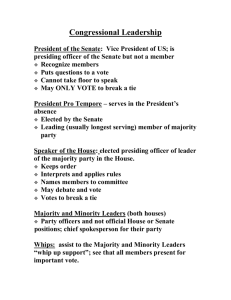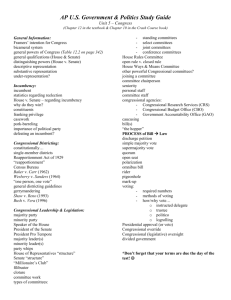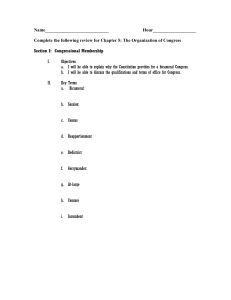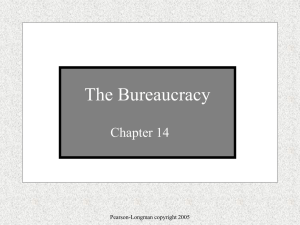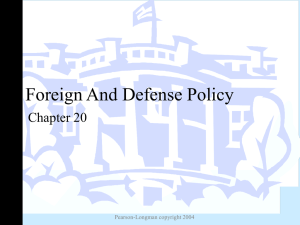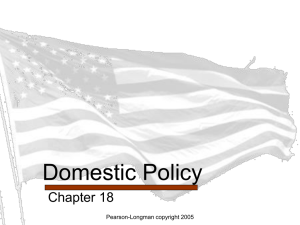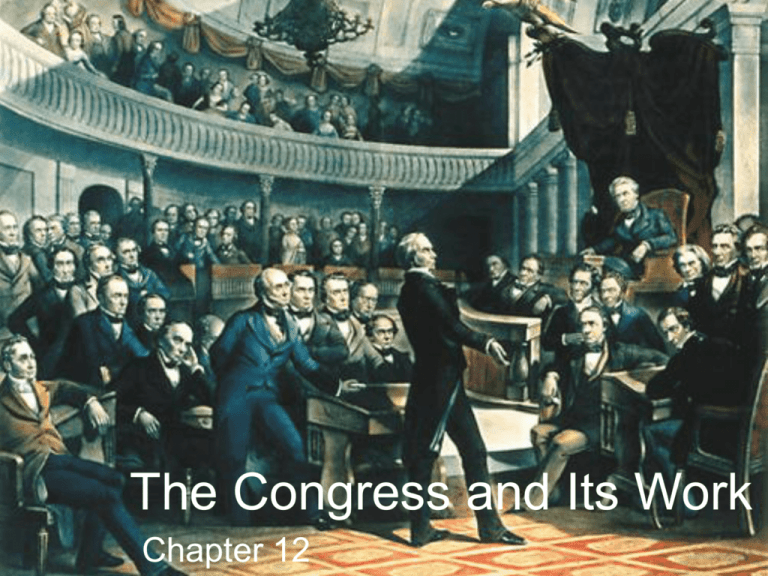
The Congress and Its Work
copyright 2004
Chapter Pearson-Longman
12
Congress: The First Branch
• Called this
because the
Constitution
lays out the
powers and
structure of
Congress in
Article I.
Pearson-Longman copyright 2004
Congress: The First Branch
• Congress is bicameral: consisting of two
chambers.
• Upper is the Senate; Lower is the House
of Representatives.
• They have roughly equal powers.
• Supported by staffs and other institutions.
– Library of Congress, the General Accounting
Office, Congressional Budget Office.
Pearson-Longman copyright 2004
Pearson-Longman copyright 2004
The Organization of Congress
• The two chambers have evolved to meet
the demands of law making
– Division of labor created the committee
system
– Need to organize large numbers of people to
make decisions led to the party leadership
structure.
– Both are more important in the House.
– Senate is small enough to operate by informal
coordination and negotiation.
Pearson-Longman copyright 2004
The Congressional Parties:
The House
• Speaker of the House
– The presiding office of the House of Representatives; normally
the Speaker is the leader of the majority party.
• Majority Leader
– Speaker’s chief lieutenant in the House and the most important
officer in the Senate. He or she is responsible for managing the
floor.
• Minority Leader
– Leader of the minority party who speaks for the party in dealing
with the majority.
• Whips
– Members of Congress who serve as informational channels
between the leadership and the rank and file, conveying the
leadership’s views and intentions to the members and vice
versa.
Pearson-Longman copyright 2004
The Congressional Parties:
The House
• Party Caucus
– All Democratic members of the House or
Senate. Members in caucus elect the party
leaders, ratify the choice of committee
leaders, and debate party positions on issues.
• Party Conference
– What Republicans call their party caucus.
Pearson-Longman copyright 2004
The Congressional Parties:
The Senate
• Given that the Senate usually includes two
members from each state – an even number –
some tie-breaking mechanism is necessary.
– Constitution provides the vice-president with authority
to preside over the Senate and to cast a tie-breaking
vote when necessary.
– President pro-tempore serves as Senate presiding
officer in the vice-president’s absence (which is nearly
all the time).
• Ordinarily goes to the most senior member of the majority
party.
• Honorific.
Pearson-Longman copyright 2004
The Congressional Parties:
The Senate
• Senate leadership has a structure of whips and expert
staff, Senate leaders are not as strong as those in the
House.
• Spend most of their time negotiating compromises.
• Unanimous Consent Agreements
– Agreement that sets forth the terms and conditions according to
which the Senate will consider a bill; these are individually
negotiated by the leadership for each bill.
• Filibuster
– delaying tactic- either speaking indefinitely or by offering dilatory
motions and amendments.
• Cloture
– motion to end debate; requires 60 votes to pass.
Pearson-Longman copyright 2004
Ups and Downs of
Congressional Parties
• Difficult to measure the strength of
congressional parties.
– Power of leadership has varied over time.
– Parties more powerful when unified. Leadership
appears more powerful.
– Leadership PACs may help leaders influence
their party members; sense of obligation if
given money.
– Members may accept some party discipline
because it is necessary for attaining policy
goals.
Pearson-Longman copyright 2004
Pearson-Longman copyright 2004
The Committee System
• Since 1989 roughly 6 to 8 thousand bills have
been introduced in each 2 year session in the
House.
• Screening process: division into committees.
– Committees do the work before it comes (if it makes
it) to the floor for a vote.
• Standing committees:
– committee with fixed membership and jurisdiction,
continuing from Congress to Congress.
• Select committees:
– temporary committees appointed to deal with a
specific issue or problem.
Pearson-Longman copyright 2004
Pearson-Longman copyright 2004
House Committees
• Three levels of importance
– Top committees: Rules, Appropriations, Ways and
Means
– Second level: deal with nationally significant policy
areas: agriculture, armed services, civil rights.
– Third level: Housekeeping items. Government Reform
and Oversight or a narrow policy venue such as
Veteran’s affairs.
– Members rarely serve on more than one top
committee.
Pearson-Longman copyright 2004
Senate Committees
• Senate committee system is simpler than that of the
House.
– Has only major and minor committees
– Appropriations and Finance are major committees as are Budget
and Foreign Relations.
• Committee power in the Senate is widely distributed.
– Each senator can serve on one minor and two major
committees, and every senator gets to serve on one of the four
major committees.
– Senators less likely to specialize
– Serve diverse constituencies within an entire state – cannot
afford to limit themselves to one or two subjects.
Pearson-Longman copyright 2004
How Committees Are Formed
• Committee system is formally under the control of the
majority party in the chamber.
• Each committee has a ratio of majority to minority
members at least as favorable to the majority as is the
overall division of the chamber.
• More important the committee, the more likely it is
stacked in favor of the majority.
• Seniority
– Practice by which the majority party member with the longest
continuous service on a committee becomes the chair.
– Has been weakened and reformed.
– Ex: Republican conference adopted a three-term limit on
committee chairs which they enforced in 2000. Enforced by
Senate Republicans in 1996.
Pearson-Longman copyright 2004
Committee Reforms
• 1970s saw much reform of committees by
Democratic caucus.
– Curbed power of standing committee chairs
– Injected more democracy into the committee
system
• Limited House committee chairs to holding one
subcommittee chair
• Subcommittee bill of rights
• Spread power more evening across
subcommittees
Pearson-Longman copyright 2004
Purpose of Committees
• Why do standing committees exist?
– Use committee system to focus on district
interests.
• Logrolling
– Colloquial term given to politicians’ trading of favors,
votes, or generalized support for each other’s proposals.
– Committees serve knowledge function.
– Committees are the tools of congressional
parties.
Pearson-Longman copyright 2004
Caucuses
• Caucuses are groups within Congress formed
by members to pursue common interests.
–
–
–
–
300 such groups in the 108th Congress
Congressional Black Caucus
Northeast-Midwest Congressional Coalition
Sportsmen’s Caucus (funded by NRA and sporting
industry)
• May be increasingly important actors in the
congressional process.
Pearson-Longman copyright 2004
How A Bill Becomes a Law
• Bill or resolution is introduced by a
congressional sponsor and one or more
co-sponsors.
• House Speaker or Senate presiding
officer, advised by chambers
parliamentarian, refers the proposal to the
appropriate committee.
– Multiple referral: said to occur when party
leaders give more than one committee
responsibility for considering a bill.
Pearson-Longman copyright 2004
How A Bill Becomes a Law
• Once a bill goes to committee, the chair gives it
to the appropriate subcommittee.
– Real work begins here.
• If subcommittee takes bill seriously it will:
– Schedule hearings
– After hearings, markup takes place
• Revising it, adding and deleting sections, preparing it for
report to the full committee.
– Full committee may repeat the process, or it may
largely accept the work of the subcommittee.
– If supported, the bill is nearly ready to be reported to
the floor.
Pearson-Longman copyright 2004
How A Bill Becomes a Law
• The chambers diverge in their process at
this point.
• In the House, bills that are not
controversial can be called up and passed
unanimously with little debate.
• Somewhat more important bills
– Fastrack through suspension of the rules
• Here debates is limited to 40 minute, no
amendments are in order, and a two-thirds majority
is required for passage.
Pearson-Longman copyright 2004
How A Bill Becomes a Law
• In the House, legislation that is especially
important goes to the Rules Committee
before going to the floor.
– Rule: specifies the terms and conditions
under which a bill or resolution will be
considered on the floor of the House.
– If the Rules Committee recommends a rule,
the floor then chooses to accept or reject it.
– Usually accepted as the Rules Committee
anticipates what the floor will tolerate.
Pearson-Longman copyright 2004
How A Bill Becomes a Law
• The Senate procedure is a bit simpler.
– For uncontroversial legislation, a motion to
pass a bill by unanimous consent is all that is
necessary.
– More important and controversial legislation
requires the committee and party leaders to
negotiate unanimous-consent agreements.
• Complicated bargains analogous to the rules
granted by the House Rules Committee.
Pearson-Longman copyright 2004
How A Bill Becomes a Law
• So what happens if a majority in one
chamber accepts the bill?
• Nothing. A bill must pass BOTH chambers
in identical form.
• Unless one chamber is willing to defer to
the other, the two must iron out their
differences.
Pearson-Longman copyright 2004
How A Bill Becomes a Law
• Usual method is a conference committee: here a
group of representatives from both the House
and the Senate work to create a compromise
version.
– If they can resolve differences, which they usually do,
the bill goes back to each chamber for a vote.
– If the chambers pass the bill, it will then go to the
president for his action. If it passes, is the process
over?
– Authorization process is over, but appropriations
process may be necessary.
Pearson-Longman copyright 2004
Pearson-Longman copyright 2004
Evaluating Congress:
Criticisms
• The congressional process is lengthy and
inefficient.
• The congressional process works to the
advantage of policy minorities, especially those
content with the status quo.
• Members of Congress are constantly tempted to
use their positions to extract constituency
benefits, even when important national
legislation is at stake.
• Sometimes, the very process of passing
legislation ensures that it will not work.
Pearson-Longman copyright 2004
Why Americans Like Their Members of
Congress More than Congress Itself
• Congress as a whole suffers from a negative
public image.
– Irony: it is the national government’s most electorally
sensitive institution.
– Puzzle: why are members of Congress elected at
such a high rate if we are so critical of the institution?
– Answer: Americans judge their own representatives
by different standards from those which they judge
the collective Congress.
– Public says they prefer a trustee but demand that
their own representative serve them as a delegate.
Pearson-Longman copyright 2004
Pearson-Longman copyright 2004
Reforming Congress:
Limit Their Terms?
• In the 1990s reform movements proposing term
limits swept the country.
• In 1997, 21 states had limited the terms of their
state legislators.
• 23 states also tried to limit their congressional
members’ terms.
• U.S. v. Thornton (1995) ruled such attempts
were unconstitutional.
• Most believe term limits would accomplish little
and potentially do harm.
Pearson-Longman copyright 2004




